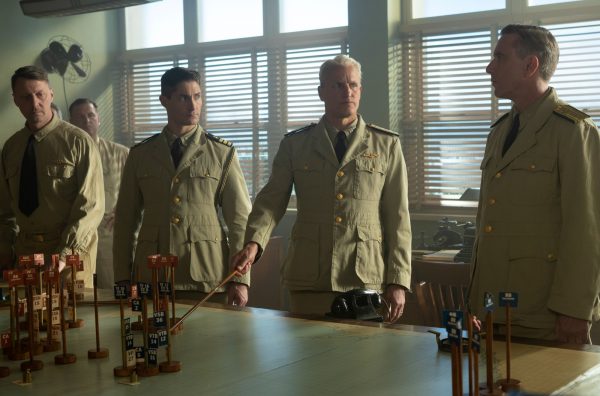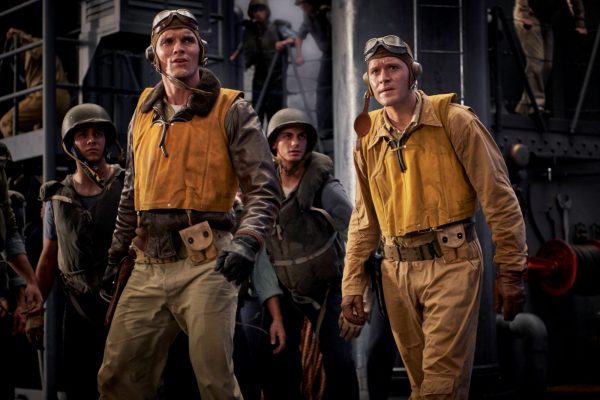
Film Critic Sam Arrowsmith dives headlong into the Battle of Midway, brought beautifully to life by Roland Emmerich
The Battle of Midway is renowned as the moment that turned the tide of the Pacific War in World War Two, and arguably, went a considerable way to helping the Allies win. As with any such historical battle, it has already seen a few film adaptations, the first of which an 18-minute documentary that was actually shot during the battle, and and the latest of which is this month’s Midway, Roland Emmerich’s new project that, while it lacks the authenticity of the first film, still does the battle justice.
“Emmerich… goes to great pains to ensure that most of the information we receive … is authentic
Emmerich himself is mostly known for disaster movies like 2012 and The Day After Tomorrow, as well as a small, minor production called Independence Day. Clearly, none of these scream ‘History Film’, but Emmerich perseveres, and the results are impressive. The historical accuracy in particular deserves note. This film became something of a passion project for Emmerich and he goes to great pains to ensure most of the information we receive as an audience is authentic. And, for the most part, it is. Of course, this is Hollywood, and a film that was entirely historically accurate would not sell to the same extent as the latest blockbuster, so a lot of the action, one feels, is played for drama. This does enrich the experience as a viewer, but those looking for a history lesson should exercise at least a degree of caution. Importantly, the film doesn’t fall into the self-aggrandisation trap, as Emmerich gives a similar level of screen time to the Japanese side, proving there were lions on both sides of the Pacific Ocean. In that spirit, the film concludes with a dedication to all the soldiers who fought in the battle, both American and Japanese. This sets it apart from other war films where the protagonists are merely battling a faceless adversary, that only exists to be foiled by the heroic army. Some scenes with the Japanese soldiers are surprisingly moving, but you’ll have to find that out for yourself.

Obviously, the centre of the action is the main battle, with the USS Enterprise (no relation) being the main staging area for the biggest battles of the film. In this section, the film milks every war movie cliché to its last drop, focusing the main attention on Dick Best (Ed Skrein), a somewhat stereotypical maverick pilot with a gum habit and a death wish, whose antics no doubt make the stuffed shirts upstairs say ‘goddammit’ a lot. He purposely cuts his engines for kicks, he has a photo of his wife for extra motivation and he frustrates his more level-headed wingmen. Then, when the USS Yorktown arrives on the scene, everyone runs out to the main deck of the Enterprise, cheering at the arrival of their allies, which feels a tad contrived, more like a war film than a historical piece.
The scene where Pearl Harbour is attacked is especially brutal, as the Japanese attack not only the ships, but the more permanent military installations, and cutting dangerously close to the homes of the airmens’ families. This gives a sense of how frightening it must have been to have been anywhere near Pearl Harbour at the time. These military installations serve as the centre of the planning sections of the movie, overseen by Admiral Chester Nimitz (Woody Harrelson) and Edwin Layton (Patrick Wilson), an Intelligence Officer who was able to predict a Japanese Offensive, but wasn’t listened to. Showing the process of US Intelligence working to anticipate Japan’s next move is riveting, and it’s a very satisfying moment when a last-minute gambit pays off, which allows the Americans to get into position for the final clash.
“A timely reminder of just how much was sacrificed
There are times when the dialogue veers into the overdramatic, and the personal motivations of the characters often get overlooked. But a film like this has to focus, most of all, on the big picture stuff. Nimitz and Layton fret over the intelligence reports and the raw data, while Best flies off with other pilots, like McCluskey (Luke Evans) and Murray (Keean Johnson), to fight the Japanese. Then the Japanese top brass, in the form of Yamamoto and Negumo, attempt to outmatch the Americans while maintaining the success of the war effort nearer to home.

Ultimately, their fates all collide at Midway. The CGI is impressive throughout, barring some issues in the more intricately designed scenes, but in the final battle it really shines. Watching the planes dive towards the Japanese carriers in a life-or-death bombing run as enemy ordinance explodes all around them is a well-rendered and extremely tense moment, that does well to make us wonder how terrifying it must have felt to have been there.
The film ends on a poignant note, with a ‘where are they now’ ending that is common for war films. The conclusion serves as a timely reminder of just how much was sacrificed by the men at the time, something especially relevant at this time of year, with Remembrance Day keeping the sacrifice of the Allied soldiers in all our minds.
Verdict:
Midway has a lot to offer. The history is (mostly) represented faithfully and the battle itself is spectacular. However, those looking for a more character-oriented approach will be disappointed, while the dialogue is often seen edging into overdramatic. Nevertheless, despite being somewhat more specialist in its theme than some blockbusters, this is an enjoyable film, particularly for history buffs.
8/10
Midway is in cinemas now.
Images © Lions Gate Films Inc. All Rights Reserved.
Comments